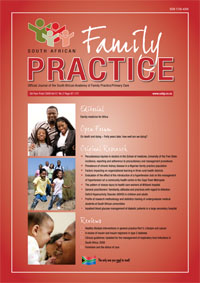Percutaneous Injuries in Doctors in the School of Medicine, University of the Free State: Prevalence, Reporting and Adherence to Precautionary and Management Procedures
Keywords:
percutaneous injuries, doctors, prevalence, reporting
Abstract
Background: Despite the official precautionary measures against percutaneous injuries, incidents still occur. Consequently, it is possible that healthcare workers could contract infections like HBV, HCV, HGV (hepatitis B, C and G viruses) and HIV (human immune deficiency virus). The most serious problem lies in the fact that percutaneous injuries are often underestimated, resulting in non-reporting of the incident. The aim of this study was to determine the prevalence of percutaneous injuries in doctors in the School of Medicine at the University of the Free State (UFS), whether the incidents were reported, and the reasons for non-reporting. Furthermore, the use of gloves during procedures was also evaluated. Methods: A descriptive study design was used. Questionnaires were administered from October 2006 through January 2007 for the collection of information. Participants were selected randomly. For descriptive purposes, respondents were divided into surgical and non-surgical groups. Results: The respondents fulfilled the following roles and/or functions in their respective departments of employment: 35 (67.3%) were registrars, twelve (23.1%) were specialists/consultants, four (7.7%) were medical officers, and one (1.9%) was exclusively involved in student training. Two of the respondents did not indicate their roles and functions in their respective departments. A total of 82 incidents of percutaneous injuries occurred. Although the surgical groups handled sharp objects more frequently per week than non-surgical groups (p-value <0.04), more incidents occurred in the non-surgical groups (p-value <0.02). Only 47.6% of the incidents were reported, while 44.4% of respondents were aware of the correct reporting procedures. Only 13.7% of respondents indicated that they always used gloves when drawing blood, 17.4% when injections were administered, and 22.4% during intravenous cannulation. However, 86.8% of respondents wore gloves when they used a scalpel or any other incision object. Of the 82 sharp object injuries that occurred, 39 (47.6%) were reported. The reasons given for non-reporting of these incidents were "too busy" (58.1%), "did not think it was serious" (48.8%), and "was not aware of the reporting procedures" (7%). The respondents (n=51) recommended that the three most important precautionary measures to take into consideration when working with sharp objects were (i) the use of gloves (23/51; 45.1%), (ii) never recapping a needle (9/51; 17.6%), and (iii) keeping the container for disposing of sharp objects close at hand (6/51; 11.8%). Conclusions: In spite of the risk of percutaneous injuries non-reporting still occurs. Although the rate of reporting these incidents could be compared with international findings published in the literature, it remains too low. Drastic measures should be taken to ensure that physicians are informed regarding the hazards of percutaneous injuries as well as the appropriate mechanisms of reporting these incidents.
Published
2009-03-06
Section
Original Research
By submitting manuscripts to SAFP, authors of original articles are assigning copyright to the South African Academy of Family Physicians. Copyright of review articles are assigned to the Publisher, Medpharm Publications (Pty) Ltd, unless otherwise specified. Authors may use their own work after publication without written permission, provided they acknowledge the original source. Individuals and academic institutions may freely copy and distribute articles published in SAFP for educational and research purposes without obtaining permission.

